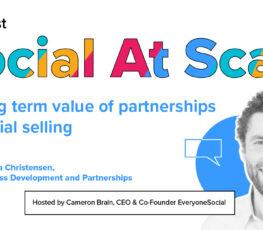Your Social Selling Initiatives
If you are reading this post, you probably work for a company that fully embraces digital and values the importance of social media to the success of the business.
Because of that, your company most likely put a social selling process in place for your sales team, or even as a company-wide effort.
Yet, often a mistake with social selling is that it’s as easy as sharing on social media, interacting, and voila! Tons of leads, new business, and increase in revenue.
As great as that would be, social selling takes time to implement, but your company should also have a unique strategy in place to make sure it is consistently effective.
Now maybe your company has a great strategy in place, your sales team is actively engaged in social media, and other employees are participating as well, but your results are still stagnant.
This is not uncommon and others have faced this same dilemma as well.
So if your social selling initiatives are still struggling or you aren’t sure what the reasoning is, then there is a good chance it is on the verge of completely failing.
However, fear not.
Your social selling efforts can be saved, you just have to recognize what’s wrong and start correcting the mistakes.
Let’s dive into the main reasons your social selling initiatives are failing.
There is a disconnect between marketing and sales for content needs
Most businesses realize the importance of marketing and sales communicating. There are tons of articles online about getting the teams to work together for the greater good of the company.
Yet, when it comes to social selling, it’s easy for that disconnect to potentially still exist when it comes to the content needs sales teams may need.
As marketing works on writing field marketing materials and blog posts, without proper communication, these resources may not be of value, thus hinder the effectiveness of your social selling process.
Both marketing and sales teams need to be in communication consistently and should have a weekly or bi-weekly meeting in place.
The sales team and any social selling participants need to be properly armed with content that aligns with buyer personas, answers problems the prospects may face, and industry related content.
If your team is not adding value, seen as the experts, or knowledge, your social selling efforts become wasteful instead of impactful.
Without this communication between teams, the content being created might not be properly aligned or content that is being shared is random.
Yet, along with that (and something we’ve mentioned in previous articles) is to coordinated great third-party content as well.
If you are posting too much branded “sales” sounding content, this will turn away prospects who are not looking to be sold yet. Again, this is where communication between the content creators, marketing, sales, and social selling participants becomes vital.
Not everyone in departments is as active as they should be
Management, sales, marketing, and whoever needs to be a part of the program and be active consistently in the process, not just sporadic.
Social media in business is a team effort and the impact from whole departments engaging consistently makes all the difference in the success of social selling.
Getting 25 salespeople sharing and engaging content to their audiences is much stronger than a message coming from a handful randomly.
Each person that adds their own view to the content strengthens the perception of your company, shows the overall expertise, and builds a trust with the audiences.
Additionally, it’s also important for management to be active and involved, otherwise, why would other team members take it seriously?

Of course, understanding the benefits of everyone in the company working together on social needs to be valued by the executives. But when that happens, your company’s social selling efforts lead to higher quality leads, more engagement, and better sales conversations.
Not enough training in the value of social media for business
Social media certainly has a stigma around it being wasteful or just full of random junk.
While that can be true, it’s still important for business leaders and managers to understand that these outlets bring value to the company.
A big challenge for companies (especially ones with thousands of employees), is that not everyone understands the value of social nor has everyone been properly trained to use it effectively.
When you roll out social selling, your company cannot just let everyone jump in and do what they think is the best process.
Because everyone’s views or thoughts on approaching social might be different, there is a huge disconnect in the overall initiative between everyone.
Not good.
You need everyone to generally be on the same page and have a fully understanding of the strategy and goals your company has in place.
If your company does not have a clear strategy and goals around social media, the social selling initiative will most likely fail.
Being social for business is vastly different than just being on the networks. For example, your Linkedin profile should not read like a resume if participating in social selling.
Many staff members not only need training in the overall concept, but how to set up social profiles for success, the process, and how to interact effectively.
Without these aspects, your social participants are going through this process blindly and unprepared.

That almost never equals success.
Not measuring social selling results
While social media and measuring results may not seem as important as other business initiatives, this is the exact mindset that could lead your social selling efforts to fail.
It’s easy to sometimes dismiss social media compared to other strategies developed in the company, but social needs to be valued just as much as anything else.
As with anything within a business, measuring the activity and results is incredibly important.
Social selling is a business strategy and should be measured accordingly. Without knowing the results, your team cannot see what is working, where to pivot, or where credit is even due.
Just like when phone conversations or emails are measured for records, things like, where leads are coming from, engagement, clicks, shares will be huge for success in social selling.
Here are three ways that businesses can measure social selling to get the most from it.
Yet, knowing this data also helps sales and marketing align for what their prospects/buyer personas may need and help expedite the buying cycle.
This helps your sales team not waste time sharing the wrong content and shortens nurturing, which can help close deals faster allowing sales to work on more prospects.
Additionally, this is why social selling is a process and strategy that will not happen overnight.

It needs to be an equal effort among all participants and continued to be measured and adjust as need to improve. But as this happens, your company will undoubtedly notice great results.
Not segmenting content based on personas
The last section to why your social selling initiatives are failing, is your teams are not segmenting content based on personas or the buying cycle.
This essentially is part of the first section of this post but is important to discuss separately.
Once everyone has been connected, is communicating, buyer personas are developed, and the content needs are being met, this newly created content needs to be bucketed.
With your buyer personas, there is also various stages of their buying cycle that prospects will be in.
If your field marketing materials or content is not segmented, your team is sharing content randomly from all different areas that may not be very impactful.
This can prolong the sales cycle and even turn prospects away who are not receiving the information they want or even just getting the wrong content.
Letting the social selling program loose to various teams to share random content is only a waste of time and will only hinder rapport with your audience.
Imagine the frustration of your audience given content and resources that have nothing to do with their challenges or interests? It’s only going to create more challenges for sales.
Instead, use social listening, monitor your current opportunities, and segment the pipeline.
This will give a clear picture of the conversations prospects are having and what content or resource you can share with them that will be beneficial.
With sales reps and social selling participants sharing the right content, everyone can reach that particular buyer or sales stage easier and effectively.
Additionally, during times where it is quiet with leads and communication, now participants can ignite those conversations while building trust and value.
Now, segmenting can be a challenge if you have tons of content, a large team, and a lot of prospects, but that’s where the value of a social selling software can help.
Without Segmenting content, everyone is engaging in social selling blindly, hoping that at some point, something connects with a buyer.
It’s inevitable that your social selling program will fail without appropriately bucketing content by buyer persona and sales cycle.
Final Thoughts
Social selling has proven to be an effective strategy time and time again for the last few years, with large and enterprise companies adopting this practice.
While it should be a highly used strategy, your company will only see success if your business understands and actively promotes the value of social media.
Of course, this is a strategy for the long haul, but when done right, social selling will help your company close deals faster and increase the number of positive conversations.
However, a lot of companies can struggle with social selling and when their programs begin to fail they don’t understand why or feel as though the process is over-hyped.
If your company’s social selling initiatives are failing, don’t judge the strategy too quickly. Instead, step back and look into what could be causing the challenges.
Most likely the reason for any failures will quickly become obvious and generally, can be remedied with some evaluation and corrections.
Social selling is rewarding when implemented correctly and in the ever-changing social sphere, your company will find success in adopting a social selling program.















